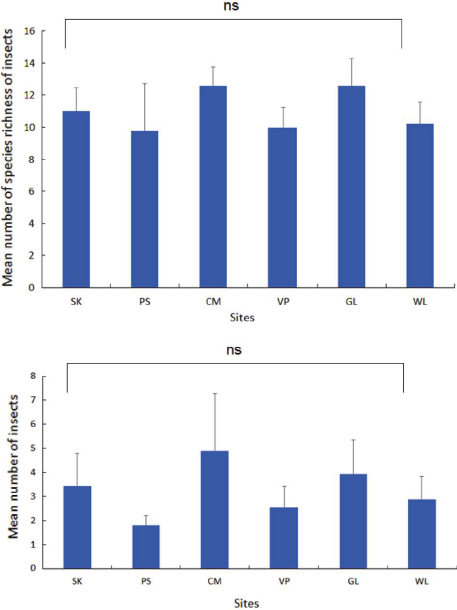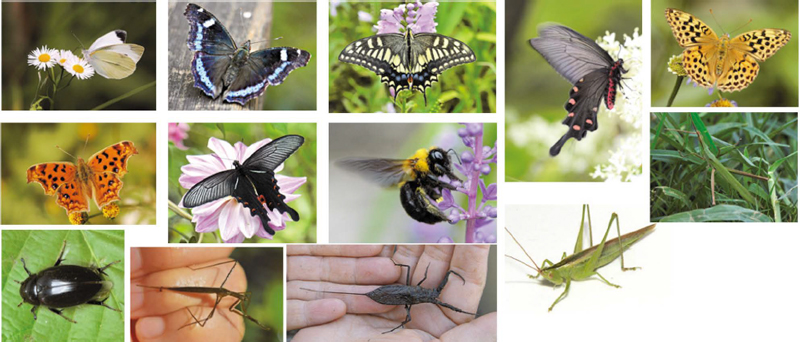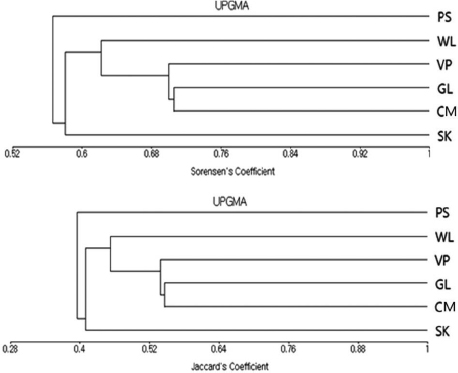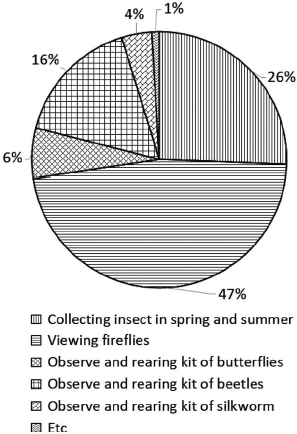
치유 프로그램 개발을 위한 곤충 테마 생태원의 곤충 다양성 연구
Abstract
An ecological garden was designed and established to support native insects’ attraction into the intentionally modified landscapes of various flower patches, grasslands and wetland encompassing 3 ha at the skirts of Mt. Saejae in Sangju from 2013. The garden could function not only as tourists healing environment but also as the conservation site of endangered insect species as well. A study was conducted to investigate insect fauna in the insect garden during 2021. Total 1,979 individuals, 68 species in 38 families and 8 Order were recorded with Arachinida and Coleoptera were dominated followed by Orthoptera and Diptera. Dominant species were Silpha perforate and Teleogryllus emma. Lepidoptera insects were dominated by Artogenia rapae, Papilio machaon, Atrophaneura alcinous and Polygonia c-aureum. Compared with the data from 2013 when the insect garden was not established, compositional difference was significant, especially in Lepidoptera of which most visitors are particularly interested in. Insect community is functioning not only for attraction but also pollination of the garden and wild plants. The results clearly demonstrate that the large pollinators including butterflies could be the major attraction for ecological garden. The faunal information provides background for selecting target species for care-program using insects. In the near future, we hope the insect ecotourism could reach the stage of educational, conservational as well as social service in the form of care-farming.
Keywords:
Ecotourism, Diversity, Healing program, Conservation, Atrophaneura alcinous, Care program서 론
치유농업은 사회적 농업, 녹색치유농업, 건강을 위한 농업 등의 다양한 용어로 표현되나 본질적으로 ‘치유를 제공하기 위한 농업의 활용 (using farming to provide care and healing)’이라는 의미를 내포하고 있다. 치유농업은 농장 및 농촌경관을 활용하여 정신적, 육체적 건강을 회복하기 위해 제공되는 모든 농업활동을 의미한다 (Kim et al., 2013a). 일과 관련하여 스트레스를 받고 있거나 건강이 좋지 않은 사람들뿐만 아니라 의학적, 사회적으로 치료가 필요한 사람들 (정신질환자, 학습장애인, 약물중독자, 사회적인 불만이 있는 사람들)을 치유하는 농업활동이다.
우리나라의 치유활동의 효과에 관한 연구는 숲 치유 (Kim, 2016; Park and Lee, 2016), 산림치유 (Jang and Koo, 2017; Park et al., 2017), 원예치유 (Park and Jung, 2015; Lim, 2017), 동물매개치유 (Moon and Kim, 2011; Kim et al., 2013b; Kim and Kim, 2016)가 있다. 치유효과는 단순히 자연을 접하는 것 보다는 자연을 인지하고 관찰하는 것에서 더 큰 치유효과를 나타낸다고 하였다 (Kaplan and Kaplan, 1989). 곤충을 이용한 심리치유 효과에 관한 연구는 애완학습곤충 5종 (장수풍뎅이, 사슴벌레, 배추흰나비, 호랑나비, 귀뚜라미)를 대상으로 곤충체험프로그램을 진행 후 심리진단변수인 ‘자아존중감’과 ‘일상적 스트레스’ 요인에 대한 사전/사후 설문조사를 실시하여 치유효과를 구명하는 연구가 있다 (Kim et al., 2013a, 2013c). Ko et al. (2015)과 Yang (2016)은 애완용 곤충이 노인들의 심리적 건강에 미치는 영향을 조사하였다. 또한, 애완곤충을 돌본 집단에서 노인성우울척도 (Geriatric Depression Scale: GDS)가 유의한 수준에서 감소하였으며 애완곤충을 이용한 체험활동은 노인들의 정신건강에 긍정적인 영향을 미치는 것으로 나타났다 (Ko et al., 2015).
동물매개 치유활동을 통한 긍정적 영향은 입원한 어린이의 회복을 촉진하고 (Kaminsky et al., 2002), 에이즈 환자의 우울증을 완화하며 (Siegel et al., 1999), 아이들의 심리사회적 발달에 긍정적 영향을 미친다 (Melson, 2003). 특히 노인에게 반려동물 또는 반려동물에 대한 애착이 신체활동 수준을 유지 또는 향상시키며, 우울한 증상을 줄이는 등의 정신건강에도 도움을 주고, 삶의 질을 향상시키는 등 긍정적 영향을 미치는 것으로 알려져 있다 (Raina et al., 1999; Baun et al., 2006). 동물매개치유 (Animal Assisted Therapy, AAT)는 일정한 훈련을 받은 반려동물 (매개동물)과 사람 사이의 매개활동을 통해 인지적, 정서적, 사회적, 교육적, 신체적 발달과 적응력을 향상시킴으로 육체적 재활과 정신적 회복을 추구하는 목적이 있다. 최근에는 동물을 매개로 하여 다른 둘 사이를 맺어주는 것이 아닌 동물과 사람이 교감해 사람이 치유를 받는다는 의미에서 ‘동물매개치유’에서 ‘동물교감치유’라는 용어로 바꿀 것을 제안하였으며 (Kim et al., 2013b), 그 주요 대상으로 개, 고양이, 말 등이 있다.
곤충은 동물의 한 무리로 종의 다양성이 풍부하고 상대적으로 몸의 크기가 작으며 여러 상징적인 의미로 이야기에서 생활에서 활용되어 인류와 함께한 역사가 길다 (Seo, 2012; Park et al., 2016). 본 연구는 곤충생태원을 활용한 치유프로그램 개발의 일환으로, 활용 대상 곤충 종을 선정하기 위하여 경북 상주시 함창읍에 있는 곤충 테마 생태원에 서식하는 곤충상을 조사하였다. 곤충생태원 내 곤충상 군집 분석과 조사된 곤충 후보 종에 대한 방문객 인식조사 및 종을 선정하여 곤충생태원형 치유 프로그램 개발에 활용하고자 한다.
재료 및 방법
1. 곤충 테마 생태원 내 곤충상 조사
경상북도 잠사곤충사업장, 곤충 테마 생태원 (N37°32′41″, E127°02′21″)은 자연환경보전 및 생물다양성 확보, 화분매개·멸종위기 곤충 보전·증식, 주변 관광자원과 연계한 생태학습 및 휴식공간 제공을 위하여 2019년에 조성되었다. 규모는 26,732 m2이며, 생태계 복원시설로 수생식물 습지원, 멸종위기종 관찰원이 조성되어 있으며 경관 체험시설 (15,953 m2)로 초화류원, 생태터널, 잔디마당, 유채원, 쉼터가 있고 놀이 체험시설로 (368 m2)는 광장, 모래놀이터, 나비생태원이 조성되어 있다. 생태원 내에는 인위적으로 밀원식물 초본류, 관목류와 목본류 123종이 식재하였다 (Table 1). 조사지역의 주요 밀원식물로는 초본류 기린초 (Sedum kamtschaticum), 목본류인 벚나무 (Prunus serrulata var. sontagiae), 국화 (Chrysanthemum morifolium), 종지나물 (Viola papilionacea) 등을 식재하여 군락을 형성하고 있다.
조사 시기는 2021년 4월부터 8월까지 곤충이 주로 활발하게 활동하는 시기에 이루어졌으며, 곤충 조사를 위해 함정트랩 (pitfall trap, - 8×12 cm, dia.×h)을 밀원식물 군락을 형성한, 기린초 (Phedimus kamtschaticus), 벚나무 (Prunus serrulata var. spontanea), 국화 (Chrysanthemum morifolium), 종지나물 (Viola papilionacea) 그리고 초지와 습지에 5반복으로 설치하였다. 유인액은 부동액을 사용하였다. 트랩의 포획물은 매주 수거하고 수거한 곤충은 75% 에탄올 용액에 옮겨 건조 표본을 제작한 후 종 단위로 분류하여 동정하였다 (손, 2013; 백과 신, 2014; 강과 김, 2020, 2021a, 2021b, 2021c, 2021d). 추가적으로 꽃을 방문하거나 자유 비행을 하는 곤충은 10분 동안 기주식물에 방문하는 곤충류를 육안조사하였다.
조사지에 따른 곤충의 전체 종 수와 풍부도는 ANOVA와 GLM, DMRT (Duncan’s Multiple Range Test)를 이용하여 평균 간 차이를 비교하였다 (SAS Institute, 2013). 군집의 종 다양성을 나타내는 지수로 Shannon-Weaver 다양도 지수 (H′), Simpson’s dominant index, 균등도 지수 (J′)를 사용하였으며 (Shannon and Weaver, 1949; Pielou, 1969), Sørensen’s과 Jaccard’s 유사도 지수 (Similarity index)를 이용하여 집락 분석을 실시하였다 (Magurran, 1988; McCune and Grace, 2002). 군집 내에서 우점을 차지하는 종은 전체 밀도에 각 종의 밀도를 나누어 백분율 (%)로 구하고 전체 밀도의 5% 이상 넘는 종을 우점종 (Dominant species)으로 하였다 (Avolio et al., 2019).
2. 곤충생태원형 치유 프로그램 개발에 따른 곤충 종 선정을 위한 설문조사
상주시 함창읍 잠사곤충사업장 곤충생태전시관을 방문하는 관람객을 대상으로 곤충을 이용한 곤충생태원형 치유 프로그램 개발에 따른 치유·정서곤충 후보 종 선정과 치유 프로그램 개발을 위하여 곤충에 대한 인식과 선호도를 설문조사 하였다. 곤충에 대한 인식 및 곤충 선호도 설문조사는 2021년 6월 19일부터 8월 22일 대략 두 달간 상주시 함창읍 잠사곤충사업장 곤충생태전시관을 방문하는 관람객 전체 523명을 대상으로 대면 설문조사를 실시하였다. 설문 문항은 총 11문항으로 기본적으로 설문대상자의 성별, 연령, 거주지역을 조사하고 곤충에 대한 인식조사와 선호하는 곤충 종 및 체험·치유 프로그램을 조사하여 곤충생태원형 치유 프로그램 개발 시 활용하고자 한다. 설문 문항에 대한 분석은 빈도 분석을 하였다.
결과 및 고찰
1. 곤충생태원 곤충상 군집 구조
곤충생태원 내 조사지에서 조사된 곤충상은 13과, 64종, 1,286개체였다. 조사된 곤충의 평균 개체수는 서식지별 유의한 차이는 보이지 않았다 (Fig. 1). 국화 군락지에서 가장 다양한 34종의 곤충이 323개체가 조사되었다 (Table 2). 육안조사에서 확인된 곤충으로는 나비목에 배추흰나비, 산호랑나비, 긴꼬리제비나비, 표범나비, 노랑나비가 우점이었다 (Fig. 3). 대부분 화분매개 기능을 하는 종들이다.

Species richness (individuals/site) and abundance (individuals/site) of insects assemblies collected from different habitats in insect ecological garden. SK: Sedum kamtschaticum, PS: Prunus serrulata var. sontagiae, CM: Chrysanthemum morifolium, VP: Viola papilionacea, GL: Grassland, WL: Wetland (ANOVA, ns=not significant).
2. 종 다양도 분석
곤충 군집의 종 다양성 정도를 나타내는 Shannon-Weaver 다양도 지수 (H′)와 균등도 지수 (J′)를 서식처별로 추정한 결과, 벚나무 군락에서 다양도 지수와 균등도 지수가 2.99, 0.89로 가장 높았으며, 국화 군락에서 2.31, 0.65로 가장 낮게 나타났다 (Table 3).
3. 유사도 분석
조사지별 곤충상의 유사도 Sørensen’s 분석 결과 0.68~0.76으로 국화 서식지와 초지 서식지에서 가장 유사하였으며 그 다음으로 종지나물 서식지가 유사한 결과를 보였다. 벚꽃나무 서식지가 다른 조사지역과 비교하여 가장 유사하지 않은 것으로 나타났다 (Fig. 2).
4. 우점종 분석
경상북도 잠사곤충사업장 곤충 테마 생태원에서 2019년 조성되어 2년 후인 2021년에 곤충상 조사 결과 주요 조사된 곤충 중 메뚜기목에 왕귀뚜라미, 딱정벌레목에는 폭탄먼지벌레, 넓적송장벌레, 꼬마검정풍뎅이가 우점하였으며, 육안조사 시 우점한 곤충으로는 나비목에 배추흰나비, 산호랑나비, 긴꼬리제비나비 순으로 조사되었다 (Table 4).

Dominant species (%) of insect species collected from different habitats in insect ecological garden
Choi et al. (2003)은 경기도 수원시 서둔동 농업과학기술원 잠사곤충부 내 시험포장의 기존 뽕밭 중 약 10,000평 정도를 활용하여 1997년도에 인공 곤충생태원을 조성하고 이곳에서 숲, 풀밭, 경작지 및 연못 4곳과 수로를 조성하여 다양한 곤충의 서식을 유도하였다 (Choi et al., 2003). 다양한 곤충이 서식할 수 있도록 벌개미취 등 초화류와 느릅나무 등 목목류 그리고 진달래 등 관목류를 포함한 곤충의 기주식물 약 280여 종을 식재하였다 (Choi et al., 2003). 곤충생태원을 조성하여 1년차인 1998년부터 4년차인 2001년까지 발생하는 곤충상을 조사하였다. 출현하는 곤충상 중 딱정벌레목의 곤충이 종 및 개체수가 가장 많았으며 우점종으로는 딱정벌레목의 등빨간먼지벌레, 나비목으로는 배추흰나비, 노린재목으로는 투명잡초노린재 순으로 나타났다 (Choi et al., 2003).
5. 치유 프로그램 개발을 위한 설문 분석
설문조사 응답자들은 대부분이 곤충생태원을 처음 방문 (63%)하였고, 98%가 재방문 의향이 있는 것으로 나타났다 (Fig. 4). 응답자의 69%가 여성이었으며 31%가 남성이었다 (Table 4). 30대 응답자가 가장 많았으며 (42%), 거주 지역은 상주 (28%), 문경 (28%) 등 인근 지역 주민이 많았다. 설문조사 결과 선호하는 곤충은 딱정벌레류가 52%, 나비류 35%, 잠자리류 10%로 선호하는 것을 알 수 있었다.

Investigated species of terrestrial and aquatic insect from different habitats in insect ecological garden.

Questionaire study of A: appearance, B: intention of revisiting in insect museum and garden and C: experience of insect rearing.

Questionnaire study of A: preferred insect group, B: perception of insects for healing purpose, C: effectiveness of healing program with insects.
곤충을 활용한 치유 프로그램 운영 시 어떤 곤충이 적합한지에 대해 질문하였을 때 딱정벌레 57%, 나비목 32%, 잠자리목 8%로 조사되었고, 치유를 목적으로 곤충을 키워볼 의향이 있는지에 대한 질문에 72%가 있다고 답하였고 28%가 없다고 응답하였다. 키워볼 의향이 있다면 키워보고 싶은 곤충은 어떤 것이 있는지 질문한 결과 장수풍뎅이 54%, 넓적사슴벌레 18%, 호랑나비 12%, 배추흰나비 8%, 누에는 7%로 나타났다 (Fig. 6).

Questionnaire study of A: suitability of insects for healing programs of insects, B: intention rearing insects for healing programs, C: intention of rearing insect for healing programs.
자연환경보전 및 생물다양성 확보, 화분매개·멸종위기 곤충 보전·증식, 주변 관광자원과 연계한 생태학습 및 휴식공간 제공을 위하여 조성되었던 곤충 테마 생태원에서 치유 프로그램을 운영할 경우 치유 프로그램 가운데 참여하고 싶은 활동에 대한 질문에서는 밤시간에 활동하는 곤충 반딧불 체험이 47%, 봄, 여름 생태원 곤충채집 프로그램이 26%, 장수풍뎅이 및 사슴벌레 관찰 및 사육키트 만들기 체험이 16%, 배추흰나비 관찰 및 나비사육키트 만들기 체험 6%, 누에 관찰 및 누에사육키트 만들기 체험 4%로 조사되었다 (Fig. 7).
꿀벌과 다른 화분매개곤충이 전 세계적으로 감소하고 있는 것으로 분석되고 있다 (Potts et al., 2010). 이로 인해 화분매개곤충 감소로 그 심각성이 대두되고 있으며 폭넓게 존재하였던 서식지의 손실과 규모는 갈수록 커지고 있는 실정이다 (Choi, 2020). 최근 유럽과 미국에서 꿀벌 감소에 따른 통계를 보면 감소하는 추세로 나타나며 그 원인으로 부적절한 영양소, 유전적 다양성, 병원체, 농약, 응애류의 상호작용으로 인한 현상으로 추측하고 있다 (Coxfoster et al., 2007; vanEngelsdrop et al., 2009). 꿀벌뿐만 아니라, 화분매개곤충 역시 감소되고 있는 실정이다 (Potts et al., 2010; Cameron et al., 2011). 이런 이유로 경상북도 잠사곤충사업장 곤충 테마 생태원은 곤충자원을 이용한 치유 프로그램 개발로 다양한 대상자에게 적용 및 확대함으로써 곤충 테마 생태원의 활용도를 높일 수 있는 동시에 꿀벌 및 다른 화분매개곤충의 생물다양성과 생태계 보전에도 도움이 될 것으로 생각한다.
또한, 장수풍뎅이, 나비, 누에 등을 관찰하고 직접 돌보기, 곤충관련 체험활동 등 치유 프로그램을 통하여 현대사회와 코로나-19를 겪은 우리에게 자연 및 곤충은 치유를 받을 수 있는 대상이 되며 곤충사육 및 곤충체험기반을 갖추고 있는 농가와 개인이 운영하는 생태원 또는 지자체 기관에 소득과 연결될 수 있다. 치유농업프로그램 단순한 신체활동을 넘어 농작물 등 농장이 가진 각종 자원과 경관 등을 이용한 활동으로 농업 활동을 통해 피로 및 분노감 감소, 자기 효능감을 높일 수 있도록 계획된 프로그램을 말한다 (Oh and Heo, 2021). 뿐만 아니라 곤충산업 시장의 활성화와 농촌의 새로운 소득원으로서의 가능성을 확인할 수 있다.
Acknowledgments
본 연구는 농촌진흥청 “곤충자원을 활용한 치유농업 적용 모델 개발” (PJ015738) 과제와 이공계대학 중점연구소과제 (NRF-2018R1A6A1A03024862)의 지원으로 수행되었습니다.
References
- 강태화, 김종현. 2021a. 딱정벌레 나들이도감 1. pp. 276. 보리출판사.
- 강태화, 김종현. 2021b. 딱정벌레 나들이도감 2. pp. 268. 보리출판사.
- 강태화, 김종현. 2021c. 딱정벌레 나들이도감 3. pp. 276. 보리출판사.
- 강태화, 김종현. 2021d. 딱정벌레 나들이도감 4. pp. 260. 보리출판사.
- 강태화, 김종현. 2020. 딱정벌레 도감. pp. 320. 보리출판사.
- 백문기, 신유항. 2014. 한반도 나비 도감. pp. 600. 자연과 생태.
- 손상봉. 2013. Insect Encyclopedia in pocket. pp. 484. 황소걸음.
-
Avolio, M. L., E. J. Forrestel, C. C. Chang, K. J. La. Pierre, K. T. Burghardt and M. D. Smith. 2019. Demystifying dominant species. New Phytol. 223: 1106-1126.
[https://doi.org/10.1111/nph.15789]

- Baun, M., R. Johnson and R. B. McCabe. 2006. Human-animal interaction and successful aging. pp. 287-302. in Handbook on animal-assisted therapy, ed. by Fine, A. San Diego, CA: Academic Press
-
Cameron, S. A., J. D. Lozier, J. P. Strange, J. B. Koch, N. Cordes, L. F. Solter and T. L. Griswold. 2011. Patterns of widespread decline in North American bumble bees. Proc. Natl. Acad. Sci. U S A. 108(2): 662-667.
[https://doi.org/10.1073/pnas.1014743108]

- Choi, G. B. 2020. Analysis of pollinating insect communities in apple orchard relative to landscape. Master’s Dissertation of Andong National University, pp. 1-84.
- Choi, Y. C., K. Y. Kim, H. C. Park, Y. B. Lee, J. K. Choi, J. Y. Choi, H. Y. Sim and T. Y. Moon. 2003. Changes of Insect Diversity after Construction of the Insect Garden. Korean J. Appl. Entomol. 42(1): 21-27.
-
Cox-Foster, D. L., S. Conlan, E. C. Holmes, G. Palacios, J. D. Evans, N. A. Moran, P.-L. Quan, T. Bries, M. Hornig, D. M. Geiser, V. Martinson, D. vanEngelsdorp, A. L. Kalkstein, A. Drysdale, J. Hui, J. Zhai, L. Cui, S. K. Hutchison, J. F. Simons, M. Egholm, J. S. Pettis and W. I. Lipkin. 2007. A metagenomic survey of microbes in honey bee colony collapse disorder. Science 318(5848): 283-287.
[https://doi.org/10.1126/science.1146498]

-
Jang, C. S. and C. D. Koo. 2017. Effects of After-school Forest Healing Program Activities on Infant’s Pro-social Behavior and Self-efficacy. Korean J. Environ. Ecol. 31(6): 595-605.
[https://doi.org/10.13047/KJEE.2017.31.6.595]

-
Kaminsky, M., T. Pellino and J. Wish. 2002. Play and Pets: The physical and emotional impact of child-life and pet therapy on hospitalized children, Child. Heal. Care, 31: 321-335.
[https://doi.org/10.1207/S15326888CHC3104_5]

- Kaplan, R. and S. Kaplan. 1989. The experience of nature: A psychological perspective. New York: Cambridge University Press.
-
Kim, K. M., J. H. Moon, S. J. Jung and S. M. Lee. 2013a. Analysis on the Present Status and Characteristics of Agro-healing in Korea. JAECD 20(4): 909-936.
[https://doi.org/10.12653/jecd.2013.20.4.0909]

- Kim, S. H., S. Y. Kim, N. J. Kim, J. B. Park, W. H. Choi and Y. J. Kim. 2013b. The effect of animal assisted activity program using insect for the elementary school children. J. Kor. Assoc. Animal Assisted Psychoth. 2(2): 1-9.
- Kim, S. Y., H. C. Park, I. G. Park and S. H. Kim. 2018. Psychological Effects of Elderly Activities Interacting with Oriental Garden Cricket. JAECD 25(2): 99-110.
-
Kim, T. K. and Y. M. Kim. 2016. Companion animals mediated activity program impact on five-years-old infant’s emotional intelligence. Korean J. Youth Stud. 23(2): 321-344.
[https://doi.org/10.21509/KJYS.2016.02.23.2.321]

- Kim, W., Y. N. Ma and H. G. Shin. 2013c. Effectiveness of Animal-assisted Intervention Program on Depression, Anxiety, Anger of Primary School Upper Graders. JEBD 29(4): 245-271.
-
Kim, Y. H. 2016. Preference Analysis of Forest Therapy Program according to the Stress Level. Korean J. Enviro. Ecol. 30(3): 434-442.
[https://doi.org/10.13047/KJEE.2016.30.3.434]

-
Ko, H. J., C. H. Youn, S. H. Kim and S. Y. Kim. 2015. Effect of pet insects on the psychological health of community-dwelling elderly people: A single-blinded, randomized, controlled trial. Gerontology 62(2): 200-209.
[https://doi.org/10.1159/000439129]

-
Lim, H. S. 2017. Effects of Horticultural Therapy Program on Solving Depression for the elderly of low-income class. JWCE 6(1): 265-282.
[https://doi.org/10.20497/jwce.2017.6.1.265]

-
Magurran, A. E. 1988. Ecological Diversity and its Measurement. London: Cambridge University Press, 179 pp.
[https://doi.org/10.1007/978-94-015-7358-0]

- McCune, B. and J. B. Grace. 2002. Analysis of ecological communities. MjM Software Design. Gleneden Beach, OR, USA.
-
Melson, G. F. 2003. Child development and the human-companion animal bond. Anim. Behav. Sci. 47(1): 31-39.
[https://doi.org/10.1177/0002764203255210]

- Moon, Y. H. and H. J. Kim. 2011. The Effect on Companion Animals on Quality of Life of Elderly People. J. Comm. Welfare 37: 455-477.
- Oh, S. Y. and C. M. Heo. 2021. A study on the Effect of Care Farming Program on Satisfaction. - Focused on the Mediating Effect of Functional Image and Emotional Image -. The Korean Society of Business Venturing, 115-159.
- Park, H. C., S. H. Kim, I. G. Park and T. M. Han. 2016. Have a good time with ‘Bugs’. Jeonju: RDA Interrobang 182: 1-16.
-
Park, K. S. and S. G. Jung. 2015. A study on the effects of horticultural therapy programs for Inmates - Focusing research on the Cheonan prison potato hydroponics -. Correct. Rev. 68(5): 147-175.
[https://doi.org/10.14819/krscs.2015.68.5.147]

-
Park, S. H., P. S. Yeon, C. W. Hong, E. H. Yeon, S. M. Han, H. Y. Lee, H. J. Lee, J. W. Kang, H. S. Cho and Y. H. Kim. 2017. A study on the Effect of the Forest Healing Programs on Teachers’ Stress and PANAS. Korean J. Environ. Ecol. 31(6): 606-614.
[https://doi.org/10.13047/KJEE.2017.31.6.606]

-
Park, S. S. and M. W. Lee. 2016. An Analysis of the Healing Effects by Types of Forest Space: Focused on Psychological Restorativeness and Satisfaction. J. Korean Inst. LA 44(4): 75-85.
[https://doi.org/10.9715/KILA.2016.44.4.075]

-
Pielou, E. C. 1969. The measurement of diversity in different types of biological collections. J. Theor. Biol. 13: 131-144.
[https://doi.org/10.1016/0022-5193(66)90013-0]

-
Potts, S. G., J. C. Biesmeijer, C. Kremen, P. Neumann, O. Schweiger and W. E. Kunin. 2010. Global pollinator declines: trends, impacts and drivers. Trends Ecol. Evol. 25: 345-353.
[https://doi.org/10.1016/j.tree.2010.01.007]

-
Raina, P., D. Waltner-Toews, B. Bonnett, C. Woodward and T. Abernathy. 1999. Influence of companion animals on the physical and psychological health of older people: An analysis of a one-year longitudinal study. J. Am. Geriatr. Soc. 47(3): 323-329.
[https://doi.org/10.1111/j.1532-5415.1999.tb02996.x]

- SAS, Institute. 2013. SAS/STAT user’s guide, Ver. 9.2 SAS Institute, Cary, NC, USA.
- Seo, J. H. 2012. A study on Active Plan for Ecotourism as Use of insects in Gurye-county. The Jirisan Region Culture Research Institute, Suncheon National University, pp. 181-199.
- Shannon, C. E. and W. Weaver. 1949. The mathematical theory of communication. pp. 177.
-
Siegel, J. M., F. J. Angulo, R. F. J. Detels, R. J. Wesch and A. Mullen. 1999. AIDS diagnosis and depression in the multicenter AIDS cohort study: The amelioration impact of pet ownership. AIDS Care 11(2): 157-170.
[https://doi.org/10.1080/09540129948054]

-
vanEngelsdrop, D., J. D. Evans, C. Saegerman, C. Mullin, E. Haubruge, B. K. Nguyen, M. Frazier, J. Frazier, D. Cox-Foster, Y. Chen, R. Underwoood, D. R. Tarpy and J. S. Pettis. 2009. Colony Collapse Disorder: A Description Study. PLoS One 4(8): e6481.
[https://doi.org/10.1371/journal.pone.0006481]

- Yang, M. J. 2016. Influence of positive emotion with pet bugs in old women: Resting state power spectral density analysis. Ph. D Dissertation of Kyungpook National University.

